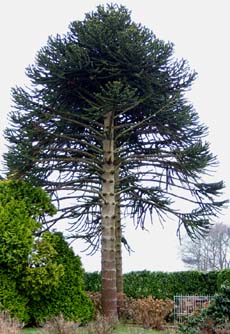Araucaria araucana Information
Identification:
Monkey puzzle is pyramidal coniferous evergreen tree, and is highly distinctive, with mature trees possessing tall, straight trunks 30 - 40 m tall, 1 - 1.5 m diameter, and an umbrella of branches at the crown. The tall trunks have been used in construction over the centuries; the wood is very resistant and has been used in buildings, shipping, and furniture. In the building industry it is often sold as 'Parana pine'. The smooth bark is greyish-brown in colour and can be up to eight centimetres thick. The horizontal branches emerge from the trunk in whorls of three to eight and the tree is covered in scale-like leaves all year round. These trees are mainly dioecious; different trees bear flowers of different sexes. The large strobili (cones) develop in the upper branches and bright orange-brown seeds are released. Outside of Chile and Argentina the largest populations of these trees are in the British Isles. The tree was introduced to England by Archibald Menzies in 1795. However, in the UK we have only ever grown this tree as an ornamental curiosity and not for its quality timber. Only a few forests of Monkey puzzle have been planted in the UK. Usually the tree is planted individually, and thus making pollination between strobili (cones) from male and female trees a rare event. Therefore, fertile seeds are very hard to come by.
General Information:
The Monkey puzzle tree is the iconic living fossil. A prehistoric tree dating back to the late Triassic period 210 million years ago and had a
world-wide spread (both hemispheres) in the Jurassic (205-145 million years BP) and Cretaceous (145-65 million years BP) periods. The tree's armoury of sharp leaves is probably an evolutionary adaptation to protect it from browsing dinosaurs. The distribution of the Araucariaceae contracted at the end of the Cretaceous during the extinction of the dinosaurs (c. 65 million years BP) when the family became extinct in the northern hemisphere.
'Monkey puzzle' is a name thought up by a Cornish joker at Pencarrow garden near Bodmin in Cornwall who remarked, after pricking his fingers on the foliage: 'It would puzzle a monkey to climb that tree'. The scientific name is drawn from the Araucano and Pehuenche people, who gather its seed as a staple food. Many animals also feed upon the seeds, which together with widespread deforestation through logging and fires the species has become endangered, and classified as vulnerable on the IUCN Red List 2007, and listed on Appendix I of CITES.
Conservation:
Araucaria araucana was declared a National Monument in Chile in 1976, a status that prohibits logging. The species is also protected in Argentina although logging pressure continues outside of National Parks. Rainforest Concern (London, UK), with the co-ordination of UACh and Royal Botanical Garden Edinburgh (UK), carried out the purchase of 161,5 ha of A. araucaria forests for their conservation in January 2004.
Distribution:
Native to, Chile
Endemic to Chile and Argentina in South America. Found in the Andes Mountains that separate these two countries. The range extends from 900 metres above sea level to the tree line at 1,800 metres. Two additional populations are found in the coastal mountain range of Chile known as the Cordillera de Nahuelbuta; these coastal populations are thought to be genetically distinct from the Andean trees. The total area of A. araucana forest types in Chile is of 253,713.6 ha. Approximately, 97% of this area is situated in the Andean Range, and only 2.9% occurs in the Coastal Range. Approximately, 65.9% of the A. araucana forests in the Coastal Range are situated in private properties. This population is currently unprotected by the State. These trees cast a unique vista in the mountainous regions where they are found, their tall, straight trunks being highly unusual at altitude. They are often found in mixed forests with the deciduous Nothofagus pumilio; the taller monkey puzzle trees emerging above the canopy of these smaller natives.
Location: Chile (-38.630753°N, -72.057213°E)
Observations
Araucaria araucana Overlay Image ©2025 Trebrown - No re-distribution without permission.

